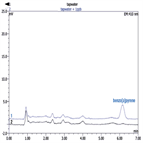Find methods for your needs
Refine by Feature
Displaying 1-5 of 8 results for Tag: Polyaromatic hydrocarbon
AB876: Automated Solid-Phase Extraction (SPE) of Wastewaters and Surface Watersfor Polyaromatic Hydrocarbons and Phthalates — Modification of EPA Method 625
Instrument Type: Automated Sample PrepEPA Method 525.2, Determination of Organic Compounds in Drinking Water by Liquid-Solid Extraction and Capillary Column Gas Chromatography/Mass Spectrometry, can be used as a basis for developing a liquid-solid extraction method for EPA Method 625, Methods for Organic Chemical Analysis of Municipal and Industrial Wastewater. Unlike the drinking water methods, however, analysis of wastewaters need to contend with particulates. The AutoTrace™ 280 Solid-Phase Extraction (SPE) instrument has features that allow analysis of samples even with high amounts of suspended solids.
AN347: Use of Accelerated Solvent Extraction (ASE) for Cleaning and Elution of XAD Resin
Instrument Type: Automated Sample PrepXAD resins are used as solid phase extraction materials for applications in water and air sampling. When received, resins are wet and contain contaminants. The current methods for cleaning and eluting require large amounts of solvent and time. Here, an XAD-2 resin is cleaned using ASE, then spiked with organochlorine pesticides (OCP) and polyaromatic hydrocarbons (PAH) standards and eluted using ASE. The results show that ASE effectively and efficiently cleans and dries the resin without damaging the particles, and is able to elute OCP and PAH compounds from XAD resin with good results.
AN1025: Simultaneous Extraction of PAHs and PCBs from Environmental Samples Using Accelerated Solvent Extraction
Instrument Type: Automated Sample PrepAccelerated solvent extraction is an established technique to efficiently extract contaminants in solid and semisolid sample matrices with less solvent and time. Polyaromatic Hydrocarbons (PAHs) and Polychlorinated Biphenyls (PCBs) are considered toxic and carcinogenic, and therefore classified as persistent organic pollutants (POPs). Typically, PAHs and PCBs are extracted separately, using different solvent combinations. Our study demonstrates extraction of PAHs and PCBs using a single method from spiked mussel and from a soil spiked with a standard reference materials (SRMs).
AN313: Extraction of PAHs from Environmental Samples by Accelerated Solvent Extraction (ASE)
Instrument Type: Automated Sample PrepAccelerated Solvent Extraction (ASE) is a new extraction method that significantly streamlines sample preparation. ASE provides a more convenient, faster, and less solvent intensive method than previously available for extraction of PAHs from solid wastes. PAH recoveries by ASE are equivalent to other more solvent intense methods such as Soxhlet or sonication. ASE also avoids the multiple washing procedures associated with sonication. The procedures described here meet the requirements for extraction of PAHs from solid waste in U.S. EPA Method 3545.
AN1100: Determination of Benzo[a]pyrene in Municipal Drinking Water Using Automated Solid-Phase Extraction and Liquid Chromatography with Fluorescence Detection
Instrument Type: HPLCA Dionex AutoTrace 280 solid-phase extraction instrument was used to reduce analyst intervention and automatically complete SPE column activation, sample loading, and the elution and collection of Benzo[a]pyrene. The eluted samples were solvent exchanged and concentrated to a defined volume, and then trace Benzo[a]pyrene in municipal water was measured using HPLC with fluorescence detection.





